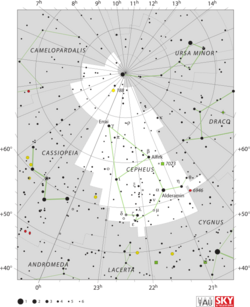Astronomy:HD 221525
| Observation data Equinox J2000.0]] (ICRS) | |
|---|---|
| Constellation | Cepheus |
| Right ascension | 23h 27m 00.91338s[1] |
| Declination | 87° 18′ 27.0304″[1] |
| Apparent magnitude (V) | 5.56[2] |
| Characteristics | |
| Spectral type | A8III[3] or A7IV[4] |
| B−V color index | 0.250±0.004[2] |
| Astrometry | |
| Radial velocity (Rv) | −10.9±2.9[2] km/s |
| Proper motion (μ) | RA: +75.736[1] mas/yr Dec.: +16.724[1] mas/yr |
| Parallax (π) | 10.3023 ± 0.0957[1] mas |
| Distance | 317 ± 3 ly (97.1 ± 0.9 pc) |
| Absolute magnitude (MV) | 0.52[2] |
| Details | |
| Mass | 2.25?[5] M☉ |
| Radius | 3.98+0.11 −0.13[1] R☉ |
| Luminosity | 44.3±0.5[1] L☉ |
| Temperature | 7466+217 −105[1] K |
| Rotational velocity (v sin i) | 110[4] km/s |
| Age | ~900[5] Myr |
| Other designations | |
| Database references | |
| SIMBAD | data |
HD 221525 is a single[7] star near the north celestial pole[5] in the constellation Cepheus. At an apparent magnitude of 5.56,[2] it can be seen with the naked eye under dark skies. It is about 30 times fainter than the nearby prominent star Polaris.[8] Based upon parallax measurements, HD 221525 is located at a distance of approximately 317 light years from the Sun,[1] but is drifting closer with a radial velocity of −11 km/s.[2]
This object is an A-type star with a stellar classification of A7IV[4] or A8III,[3] suggesting it is an evolving star on the subgiant or giant branch, respectively. It has a relatively high rate of spin, showing a projected rotational velocity of 110 km/s.[4] The star has four[1] times the radius of the Sun and is radiating 44[1] times the Sun's luminosity from its photosphere at an effective temperature of 7,466 K.[1]
References
- ↑ 1.00 1.01 1.02 1.03 1.04 1.05 1.06 1.07 1.08 1.09 1.10 1.11 Brown, A. G. A. (August 2018). "Gaia Data Release 2: Summary of the contents and survey properties". Astronomy & Astrophysics 616: A1. doi:10.1051/0004-6361/201833051. Bibcode: 2018A&A...616A...1G. Gaia DR2 record for this source at VizieR.
- ↑ 2.0 2.1 2.2 2.3 2.4 2.5 Anderson, E.; Francis, Ch. (2012). "XHIP: An extended hipparcos compilation". Astronomy Letters 38 (5): 331. doi:10.1134/S1063773712050015. Bibcode: 2012AstL...38..331A.
- ↑ 3.0 3.1 Abt, Helmut A.; Morrell, Nidia I. (1995). "The Relation between Rotational Velocities and Spectral Peculiarities among A-Type Stars". Astrophysical Journal Supplement 99: 135. doi:10.1086/192182. Bibcode: 1995ApJS...99..135A.
- ↑ 4.0 4.1 4.2 4.3 Cowley, Anne; Fraquelli, Dorothy (1974). "MK Spectral Types for Some Bright F Stars". Publications of the Astronomical Society of the Pacific 86 (509): 70. doi:10.1086/129562. Bibcode: 1974PASP...86...70C.
- ↑ 5.0 5.1 5.2 Jim Kaler. "HR 306 and HR 8938". Stars.astro.illinois.edu. http://stars.astro.illinois.edu/sow/hr306.html.
- ↑ "HD 221525". SIMBAD. Centre de données astronomiques de Strasbourg. http://simbad.u-strasbg.fr/simbad/sim-basic?Ident=HD+221525.
- ↑ Eggleton, P. P.; Tokovinin, A. A. (September 2008). "A catalogue of multiplicity among bright stellar systems". Monthly Notices of the Royal Astronomical Society 389 (2): 869–879. doi:10.1111/j.1365-2966.2008.13596.x. Bibcode: 2008MNRAS.389..869E.
- ↑ Calculation: [math]\displaystyle{ (\sqrt[5]{100})^{5.56-1.97}\approx 27.2 }[/math]
External links
- Jim Kaler. "The Polar Project". University of Illinois. http://stars.astro.illinois.edu/sow/polaris-t.html.
- HD 221525 on WikiSky: DSS2, SDSS, GALEX, IRAS, Hydrogen α, X-Ray, Astrophoto, Sky Map, Articles and images
 |


